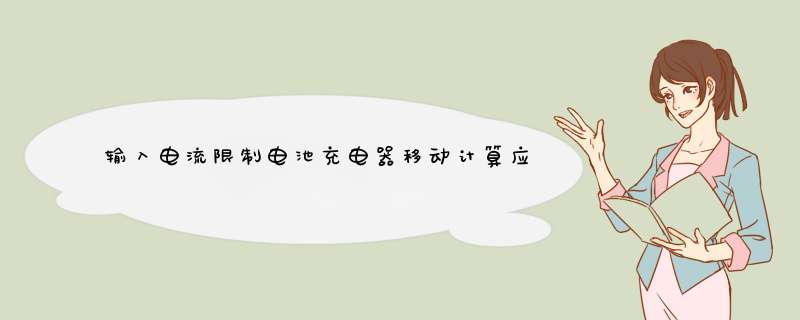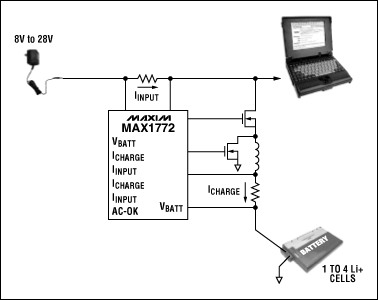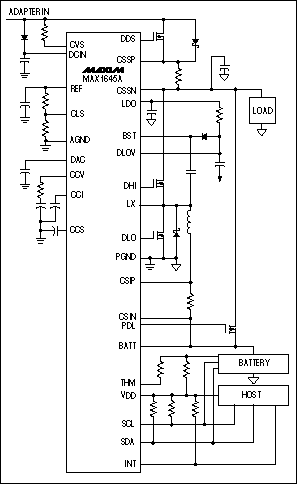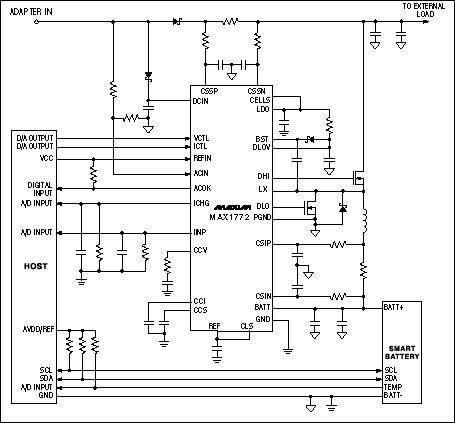
- Quick View Data Sheet for the MAX1645/MAX1645A
- Quick View Data Sheet for the MAX1772
- Technical Support: Power
The trend in the mobile computing market over the last few years has been one of faster devices and decreasing prices. Manufacturers are using sophisticated technology and new methods to minimize the cost of mobile computers.
Input Current LimitingInput current limiting is one such feature that allows mobile computer manufacturers to reduce the cost of AC adapters used with these devices. When an AC adapter is connected to a mobile computer in use, it not only powers the system but also charges the batteries. Depending upon the power requirements of the system, the power drawn from the AC adapter will vary. In order to ensure that the AC adapter can safely meet the power requirements of such a system, it has to be able to supply the maximum power required by the system and charge the batteries at the same time, without getting overheated. The result is an AC adapter that is "oversized" and expensive.
Input current limiting is an advanced feature that can help reduce the cost of the AC adapter while meeting the power requirements of the system and charging the batteries. It works by monitoring the power requirement of the system and adjusting the charging current supplied to the batteries to keep the power drawn from the AC adapter within its specified limits. Figure 1 shows a simplified schematic of a charger that implements the input-current-limiting feature. When the current drawn by the system increases, causing a corresponding increase in the current drawn from the AC adapter (IINPUT), the charging current (ICHARGE) supplied to the batteries is reduced, and vice versa.

Figure 1.
In the past this feature was implemented using a system power-management microprocessor. The microprocessor would monitor the power drawn by the system and control the battery-charger output current. Such a method was complicated, requiring sophisticated firmware and external components including a separate current sense amplifier, making it expensive. In addition, the response time of such a system was slow, because decisions were being made in the firmware.
Battery Chargers from Maxim with Input Current LimitingMaxim has introduced two new chargers, the MAX1772 and the MAX1645A, that include the input-current-limiting feature. The MAX1772 and the MAX1645A differ in the communication interface used to control the charging voltage and current. Whereas the MAX1772 employs an analog interface for controlling charging parameters, the MAX1645A uses an SMBus interface for the same purpose.
Both chargers integrate the input-current-limiting feature using a minimum number of external components. Two external sense resistors are used to sense the current being drawn from the AC adapter and the battery-charger output current. The amplifiers required for sensing the currents and associated logic circuitry for making decisions and changing the battery-charger current are fully integrated in the ICs. This not only helps in reducing cost but also improves the speed of system response.
Both the MAX1772 and the MAX1645A work by monitoring the current being drawn from the AC adapter and comparing it to an externally adjustable current limit. Typical application circuits for both chargers are given below. The current limit is set based on the current-handling capability of the AC adapter. Generally, this limit is chosen to optimally fulfill the system power requirements while achieving a satisfactory charging time for the batteries. If the AC-adapter current exceeds the set threshold, the charger responds by cutting back on the charger current, thereby keeping the current drawn from the AC adapter within the set limit. With such a battery charger, the AC adapter doesn't need to be "oversized" to meet maximum system and battery-charging requirements simultaneously, reducing AC-adapter cost.

Figure 2.

Figure 3.
欢迎分享,转载请注明来源:内存溢出

 微信扫一扫
微信扫一扫
 支付宝扫一扫
支付宝扫一扫
评论列表(0条)